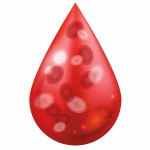A treatment regimen containing the experimental hepatitis C virus (HCV) antiviral telaprevir can cure HCV after 24 weeks of treatment—without requiring a full 48-week course of therapy—in people with HCV genotype 1 who have undetectable virus levels after 4 and 12 weeks of therapy. These early results from a clinical trial conducted by Vertex Pharmaceuticals were reported in a press release from the company.
Telaprevir is a member of a new class of HCV therapies called protease inhibitors. Studies suggest that telaprevir, when combined with the standard drugs pegylated interferon and ribavirin, can increase success rates by 50 percent or more. Treatment success, called a sustained virological response—or SVR—means achieving and maintaining undetectable HCV levels for six months after completing a course of HCV treatment.
Results from a Phase III clinical trial called ADVANCE suggest that telaprevir works well for patients with HCV genotype 1, which is the most common yet difficult-to-treat form of HCV in the United States. Whereas patients with HCV genotype 1 typically require 48 weeks of treatment, ADVANCE suggested that combining telaprevir with standard therapy for the first 12 weeks of treatment increased the percentage of people with undetectable genotype 1 HCV levels after 4 and 12 weeks, compared with standard therapy alone. In these patients, dubbed extended rapid virologic responders (eRVRs), all drugs could be stopped after just 24 weeks without jeopardizing the likelihood of an SVR.
As encouraging as these results were, researchers and advocates remained skeptical. In turn, Vertex’s researchers designed a second Phase III study, called ILLUMINATE. In that study, Kenneth Sherman, MD, PhD—from the University of Cincinnati College of Medicine and a principal investigator of the trial—and his colleagues enrolled 500 people who had HCV genotype 1, none of whom had been treated previously, and randomized them to either 24 or 48 weeks of HCV treatment.
All of the participants in ILLUMINATE took standard HCV treatment—pegylated interferon plus ribavirin—combined with telaprevir for 12 weeks. After 12 weeks, people stopped the telaprevir and continued on therapy for an additional 12 weeks (24 weeks of treatment in all).
Patients who achieved an eRVR—undetectable HCV levels after 4 and 12 weeks of therapy—were then randomized to either stop therapy altogether after 24 weeks or continue treatment for a total of 48 weeks. Patients who did not have a eRVR were automatically continued on standard therapy for 48 weeks.
The analysis described in the Vertex press release involved only those who achieved an eRVR and were randomized to either discontinue or remain on therapy after 24 weeks. Full results from the study, including those who did not achieved an eRVR, will be reported at a later date.
Overall, Sherman and his colleagues found that eRVRs who stayed on treatment for 48 weeks had no more chance of treatment success than those who completed only 24 weeks of treatment. In all, 92 percent of eRVRs who took 24 weeks of treatment were cured of HCV, compared with 88 percent who took treatment for 48 weeks.
The percentage of people who had undetectable HCV levels at the end of treatment but whose HCV later returned (relapsers) was 5.9 percent in eRVRs on 24 weeks of treatment compared with 1.9 percent of those on 48 weeks of treatment.
The overall number of people who achieved an HCV genotype 1 cure, regardless of their early virologic response, was also relatively high, at 72 percent.
“The viral cure rates seen in ILLUMINATE showed that there was no benefit to extending telaprevir-based therapy to 48 weeks for the majority of people,” Sherman said. “Patients who had a rapid response to telaprevir-based regimens at weeks four and 12 had a high likelihood of achieving a cure with 24 weeks of total treatment, which may provide important information to motivate people to continue therapy.”
Thus far, studies have taken place only in HCV monoinfected individuals—people infected only with HCV, not coinfected with HIV and HCV. Trials in HIV-coinfected people are planned and should get underway in the coming months. In the meantime, however, good results in monoinfected people offer real hope to people who are coinfected. Facing the prospect of 48 weeks of current HCV treatment—which has significant side effects and only works 25 percent of the time—many coinfected people feel conflicted about starting therapy. A new treatment, however, that offers the chance of better results in half the time would represent a significant advance.
Advertisement
Advertisement
Advertisement






Comments
Comments